Celebrate 70 Years of AMC with 10 of Our Favorite Cars
AMC was founded on May 1, 1954, when Hudson Motor Car Company and Nash-Kelvinator Corporation merged to better compete and survive against the Big Three. The plan worked, to an extent: AMC outlived Studebaker, Packard, and Kaiser-Jeep, the latter of which survived the longest, making it to 1970 before it was acquired by AMC. In 1987 AMC itself was purchased by Chrysler, and today only Jeep survives.
Over the brand’s 33-year run, it built family haulers, sports cars, off-roaders, and innovative compacts with a fraction of the resources of the Big Three, and the models often punched above their weight in performance and style. To celebrate the brand’s 70th anniversary, we’ve picked 10 of our top AMC models to highlight, in roughly chronological order, along with picks of our favorite variant from each model.
AMC Ambassador
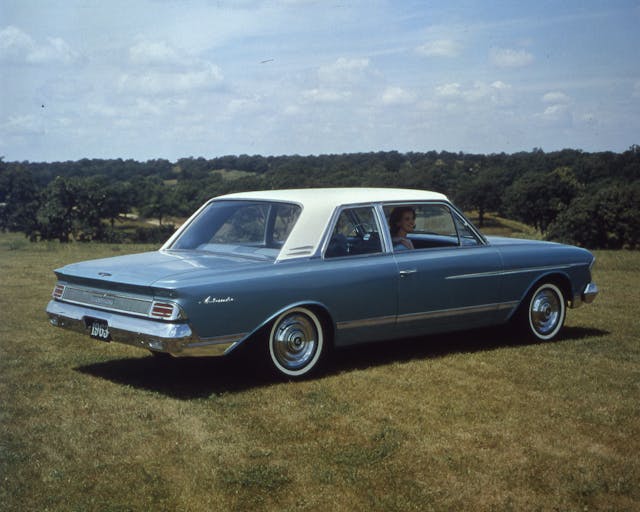
AMC’s full-size car was built in eight generations from 1958 to 1974 and could be had in a wide range of body styles, which often changed yearly, typical of its Big Three competition in that era. A rare sight at car shows, these big cruisers are bursting with style, as the Ambassador often served as the flagship model for AMC. In 1968, Ambassadors came equipped with standard air-conditioning while the feature was still optional across most of the industry, even on much more expensive models.
Our pick: While we love the funky, finned, ’50s four-door hardtop wagons, as well as the stylish two-door hardtops, we’ve got to go with the 1965–66 wagon. The interesting front-end treatment, with stacked headlights and horizontally mirrored grille, makes it look almost like a concept car. It was practically built for a Route 66 road trip. Besides, most of the rest of our picks are gonna be two-doors—we’ve got to be at least a little bit practical.
AMC Rambler American
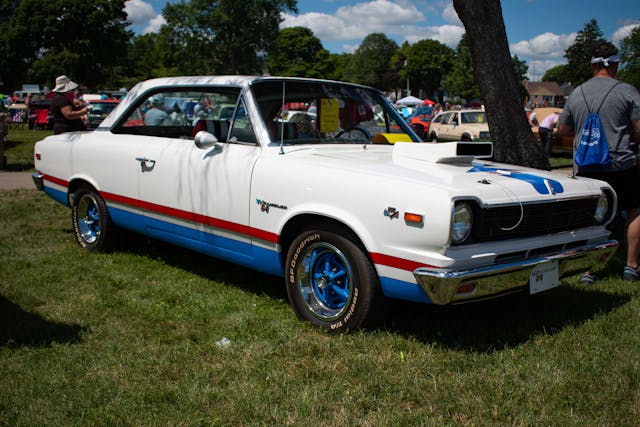
Built over three very different generations, the Rambler began as an elegant, sleek compact that stood out from the larger cars that were then dominating the market; it practically looked like a European import. The third generation introduced V-8 power to make a compact muscle car, the SC/Rambler, that would take on the sportier variants of the Dodge Dart, Ford Falcon, and Chevy Nova.
Our pick: The SC/Rambler with its red, white, and blue paint scheme is an easy choice, but we’ll go with some of AMC’s later models when it comes to patriotic color schemes. For our favorite Rambler, we’re gonna cheat a bit and pick an IKA Torino, which is what you get when Pininfarina gives this AMC a makeover. Built and sold by Industrias Kaiser Argentina and later Renault, the South American models were made famous thanks to their racing prowess. We’ll be honest, we wouldn’t care if they never took a checkered flag; we’re just interested in the looks.
AMC Rambler Marlin
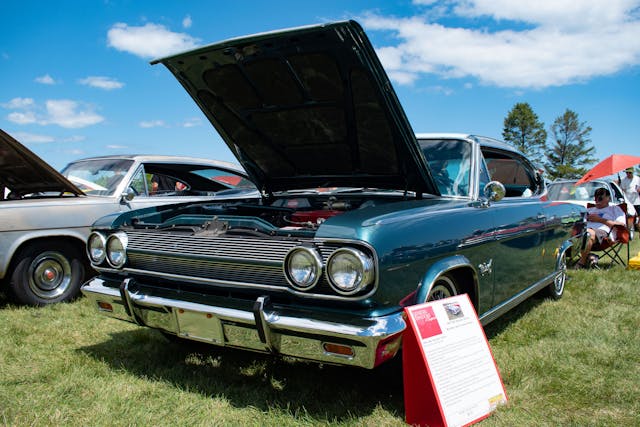
AMC’s midsize Rambler Classic spawned the fastback Rambler Marlin, whose sleek lines inspired Dodge to build the first-generation Charger. After just two years, Marlin moved to the larger Ambassador platform and kept the fastback design.
Our pick: We’re going to select the first-year Marlin, the 1965 model, which essentially serves as our favorite version of the Rambler Classic as well.
AMC Javelin
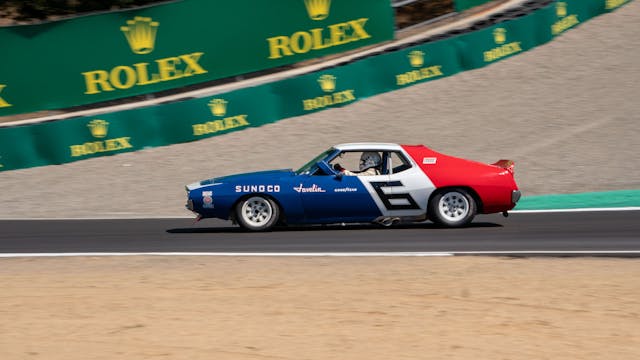
Whether it’s the rather understated early versions or the audacious, flared variants that came later, AMC’s take on the pony car is an attractive package. Like any good pony car, the Javelin was available with options to customize the style and performance, with several potent V-8 available. A blue, white, and red Javelin campaigned by Mark Donohue in 1971 brought the Trans Am championship to AMC for the first time, and in 1972, AMC nabbed driver George Follmer to repeat the performance.
Our pick: The one-year-only 1970 models featured a unique front end that is just different enough to notice from a distance. We’ll go with a 390 V-8 and a four-speed, in the red, white, and blue paint scheme that was the opposite orientation of the SCCA models.
AMC AMX
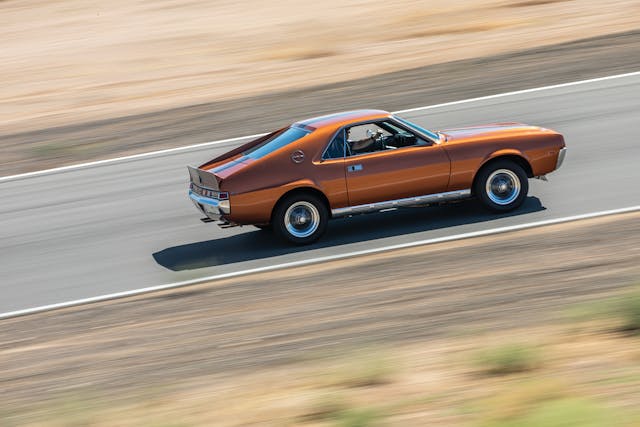
To create a two-door sports car and compete with Chevrolet’s Corvette, AMC shortened the Javelin and restyled it from the doors back. It’s a cost-cutting theme to which the company would return, but the AMX was arguably the best implementation of the strategy. AMC was proud to announce that the AMX started at less than $4000, the price of a loaded Mustang or Camaro. Production lasted from 1968 to 70, at which point “AMX” became an option package for the Javelin, then the Hornet, and eventually the Spirit.
Our pick: The AMX came standard with a V-8 and a four-speed with Hurst shifter, so pick your favorite AMC V-8, pick your favorite color, and go.
AMC Rebel

AMC’s mid-size follow-up, the Rambler Classic, filled a lot of roles as it was built in convertible, sedan, coupe, and wagon body styles. All of them look good, with interesting design cues like fenders and quarter panels with bulges to mimic the lines of their close-fitting bumpers, a design feature shared with the 1967–68 Ambassador.
Our pick: For style, it’s tough to beat the sleek looks of the 1967–69 hardtop, but we’ll still have to go with the 1970 Rebel Machine. It featured a 340-hp 390 V-8 that breathed through a sizable hood scoop and was available with a red, white, and blue paint scheme. It was loud, it was brash, and it was a solid performer thanks to a more powerful V-8 than even the AMX had. What’s not to love?
AMC Hornet

The compact Hornet sedan, successor to the Rambler American, was offered in two- and four-door variants when it debuted in 1970. A year later, it was joined by the Sportabout wagon, which AMC proudly claimed was “America’s only compact station wagon.” A sporty two-door hatchback joined the party in 1973. All of the body styles are rather attractive in their simplicity; perhaps that’s why we think they’ve aged so well. The muscular SC/360 version used a, you guessed it, 360 V-8 engine and was offered in muscle-car-appropriate colors and with a ram air induction system.
Our pick: While the most famous Hornet has to be the red hatchback from The Man With the Golden Gun (1974), the car that completed the miraculous corkscrew jump, we’ll take an earlier SC/360 model. How about a 1971 with the optional four-barrel, 285-hp engine with dual exhaust, four-speed manual, and 3.91:1 rear-axle ratio with Twin-Grip differential?
AMC Gremlin

AMC was used to being an underdog and doing a lot with a little. When it needed a more affordable, smaller car, it took the already compact Hornet, cut out 12 inches of wheelbase, and hacked off the rear to create the Gremlin. Sound familiar? Compared to the wonderfully proportioned AMX-GT concept that spawned the truncated subcompact, the Gremlin is a bit awkward. That doesn’t stop us from loving the odd little hatchback.
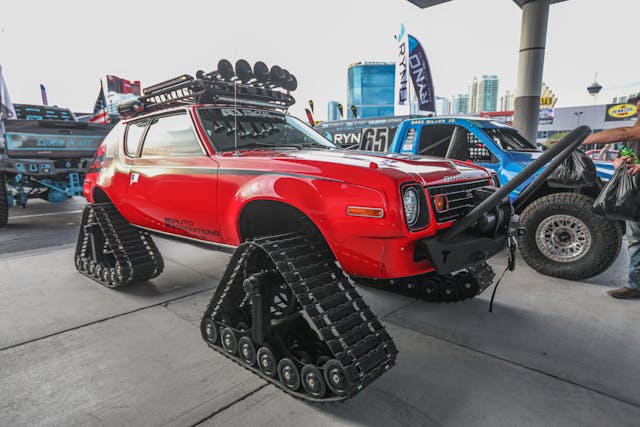
Our pick: Our initial thought was this wild, tracked Gremlin we spotted at SEMA in 2022, but how about something a bit more practical—a 1972 Gremlin X in Wild Plum? The 304 V-8 wasn’t a brutal powerhouse at the time, yet it was still punchy in the lightweight Gremlin. A modern tune-up with a decent cam and intake would make it a zippy runabout.
AMC Pacer
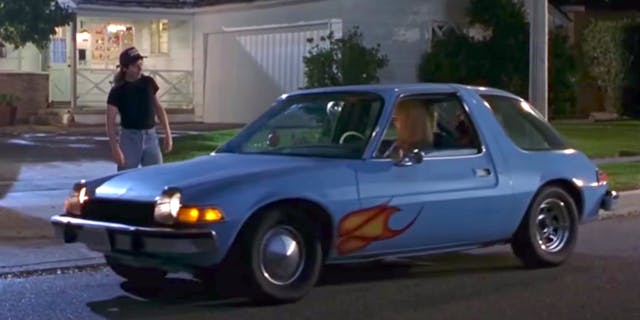
You can’t say that AMC was averse to taking risks. The Pacer offered unique, even strange styling with some practical benefits. The most oft-cited example is, of course, the passenger side door, which was longer than the driver’s to encourage rear-seat passengers to enter and exit on the curb side, where it was safer. The efficiently packaged interior offered fantastic visibility thanks to a greenhouse that used more window area. The car was also designed to be easy to repair.
Our pick: Our favorite Pacer has got to be the Mirthmobile, the only famous Pacer in existence. With a roof-mounted red rope licorice dispenser and a dash-mounted cup dispenser to go along with what appears to be an on-board water supply, it has tremendous road-trip potential.
AMC Eagle

These utilitarian sedans and wagons aren’t particularly eye-catching and would have blended in with plenty of their contemporaries if it weren’t for the fact that they rode a bit taller on their 4×4 suspensions. The drivetrain made them a precursor to the ubiquitous crossover and served to highlight AMC’s ambitious attempts to carve out new segments in the market. The Eagle sedans and wagons were based on the Concorde, the successor to the Hornet.
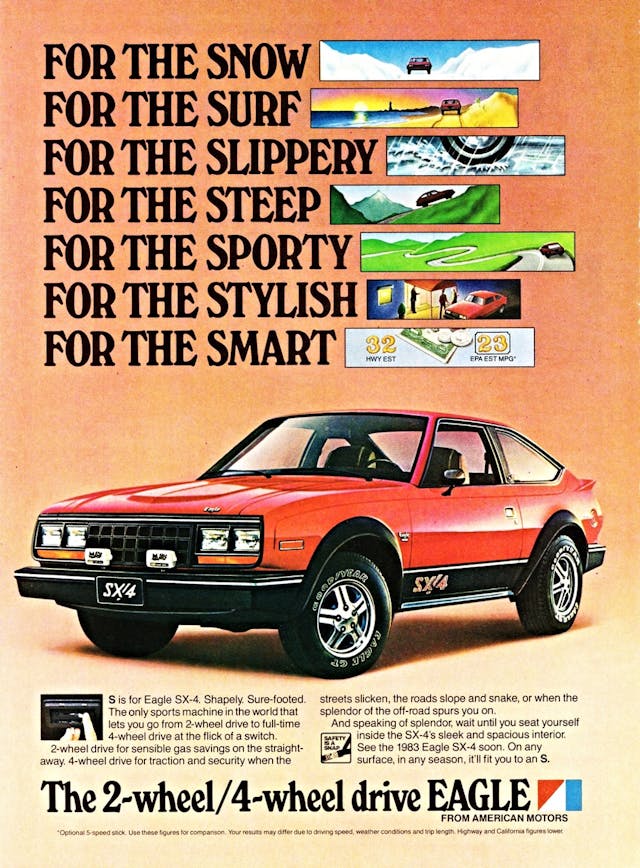
Our pick: The SX/4 three-door that was based on the smaller AMC Spirit is a rare sight today and would make for a fun rallycross-inspired toy.
Bonus:
XJ Jeep Cherokee

The XJ wasn’t branded as an AMC, but AMC was Jeep’s steward from 1970 to 1987 and the Cherokee was AMC’s largest contribution to the brand over that period, as most of the other models available were carryovers from Kaiser.
These boxy wagons weren’t the first compact SUV, although they set the stage for the future in several important ways. With lightweight unibody construction and a solid front axle with coil-spring suspension, the XJ Cherokee was maneuverable and capable off-road and had a decent ride on-road. Its quadra-link suspension made its way to the original Grand Cherokee in 1993 and TJ Wrangler in 1997. The Grand Cherokee was initially planned to replace the Cherokee, although strong sales kept the XJ in production until 2001 in the United States. Reskinned versions were on sale in China until 2014.
Our pick: A 1997–99 4.0-liter model to get the best of the upgrades that started in 1997 but the last of the high-pinion Dana 30 front axles.
This list had to be cut short, but we’ve managed to cover a pretty big swath of AMC’s lineup. Our favorites were biased toward the ’60s and ’70s, so let us know if we’ve overlooked your number-one AMC.
***
Check out the Hagerty Media homepage so you don’t miss a single story, or better yet, bookmark it. To get our best stories delivered right to your inbox, subscribe to our newsletters.



Fun article makes me remember growing up traveling in the way back of a 57 (I think) Rambler wagon, I used to ride my bicycle down to the Rambler AMC dealer and look at the Scramblers, Javelins, AMXs I say I would own one someday. I did 69 AMX Super Stock car 390 Go Pack, 4 speed, dual 4 barrel crossram that car moved, wish I never sold it. Sister had a Gremlin X Levi, Mom drove a Cherokee, Dad, older brother and I Jeep pickups and CJs, still have my 65 Gladiator, it still runs, squeaks, rattles, and drives.
We had an AMC Hornet wagon that was an absolute blast. It was a sleeper – small and very sedate looking wagon with a V8 under the hood. A real screamer off the green lights.
Spent many an hour wrenching on a straight-6 196 motivator for a little Rambler American with my bestie Dave C. If only we knew that a warped head is a dead head we could have saved ourselves a lot of time and grief.
I disagree Since my Dad bought a 65 Marlin 2 yrs old so I’m 12 and crazy in love with that car red withe the black stripe and it moved too I was so disappointed when he traded it for the first year Hornet what a let down he had a Matador and a Pacer and a Spirit I drove the Pacer on the highway once hated it.
Did you leave out the ’57 Rebel? Shame!
Shame indeed. Especially the cutting edge, at that time, mechanical fuel injection.
Metropolitan – a cute, kitschy sub-compact car that has everlasting charm. American – a hugely successful compact car re-introduced during the recession of 1958 that was a stark contrast to everything made by the Big 3.
I have had a number of AMC’s over the years but my favorite is still the TA champ version from 1972. Mine, for which I have owned over 50 years, with its 401 4speed ran documented low 11’s in the mid to late 70’s. I also have had several of the Hornet Sportabout models and currently redoing a 76 V8 for touring around in. AMC was truly ahead of their time.
Every once in awhile you would see a AMC family. The minister who lived behind us was one. I’m a Hash fan as well as pink and black never looked so good on a mismash of styling cues in a last ditch effort to save a marque. A early Hornet was a inexpensive vehicle that may or may not of been reliable depending on the attitude of the UAW that week. Kaiser/Jeep is only mentioned as they were bought by AMC. The OHC 6 cyl Hurricane truck engine ( “crank snapper”) with Webbers and hot cam was a dirt track killer in Brazil if we want to talk about Kaisers
Back in high school, I had friends who owned a Scrambler with the 390c.i. four speed and the red, white and blue paint and interior treatment. One of the coolest cars in the lot! Another friend had an AMX, also very cool. Loved the styling of this car. The swing in styling with AMC is quite interesting to see, especially when presented as a the collection above is.
You forgot the 1957 Rebel. Fastest production car that year!
Living in Wisconsin not far from where rambler were built, they were everywhere. Just a good family car. Our family had many from 62 till about 82 and we loved everyone of them. I was 14 and learned to drive in a 64 wagon and my first car was a 65 classic 660. The best way to describe a rambler is solid.
My father worked at a Pontiac-Cadillac-Rambler dealership during the late ’50s to the mid ’60s. I recall one year in the early ’60s when Rambler and Pontiac were engaged in a head-to-head duel for a top ten spot in overall nationwide sales. This prompted window banners in the showroom declaring “GO PONTIAC! BEAT RAMBLER!” and “GO RAMBLER! BEAT PONTIAC!”. A win-win situation for the salesmen!
Yes- we had a 65′ Classic 550 with 327 4-bbl – one ‘unique feature’ was the dual-master cylinder- which didn’t become common till 67′, I believe. And the ‘ceramic armored’ exhaust system. A neighbor had an Ambassador with ‘matching upholstery pillows’ and the excellent ‘Weather Eye’ heater. All in all they ‘gave a little extra’ for the family buyer!
https://safebraking.com/retro-rambler-double-safety-brakes/
Brandan, it may not be as popular as the Mirth Mobile but don’t forget that other “Famous Pacer”. The AMC Pacer from the 1997 movie “Good Burger” is now parked at the Hi-Pointe Drive-In burger joint in St. Louis.
Back in the 70’s I owned a ’74 Gremlin X with a 304 V8 and three speed stick. Factory axle ratio was 3:54. I recurved the distributor (AMC used Delco) and ran Sunoco 260 so I could advance the initial timing, removed the emission pump and hardware, added a dual exhaust and reversed air cleaner lid. It ran a 15.9 at 84 mph at the dragstrip on a hot day, not bad for malaise era car. Recorded 0-60 in 7.1 seconds by stopwatch. Getting traction was an issue with the skinny E70 tires and no limited slip. I beat a 325hp 396 Chevelle by a nose that day as well 🙂 Didn’t handle or stop very well but still a hoot to drive.